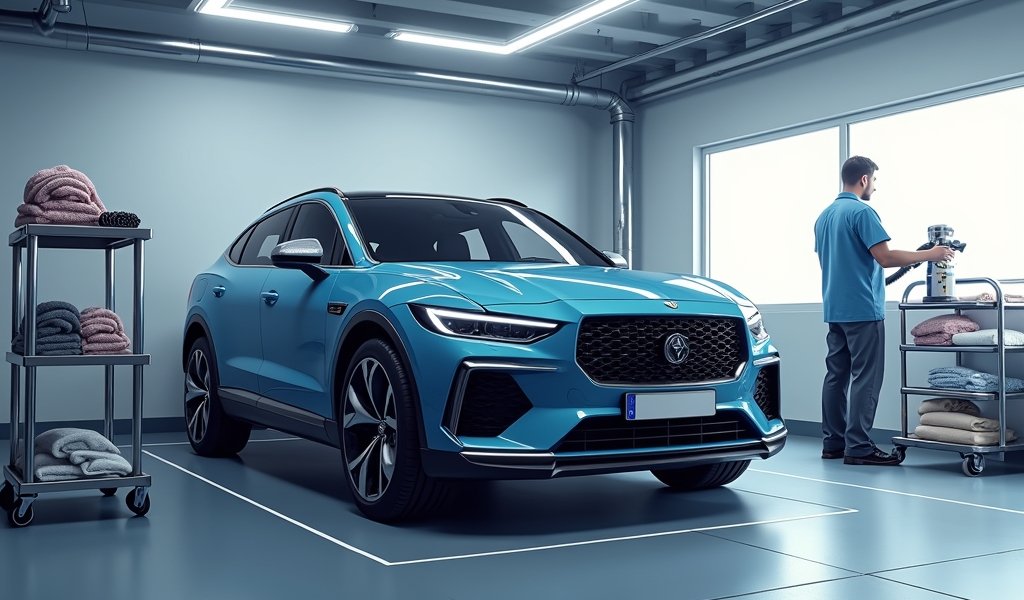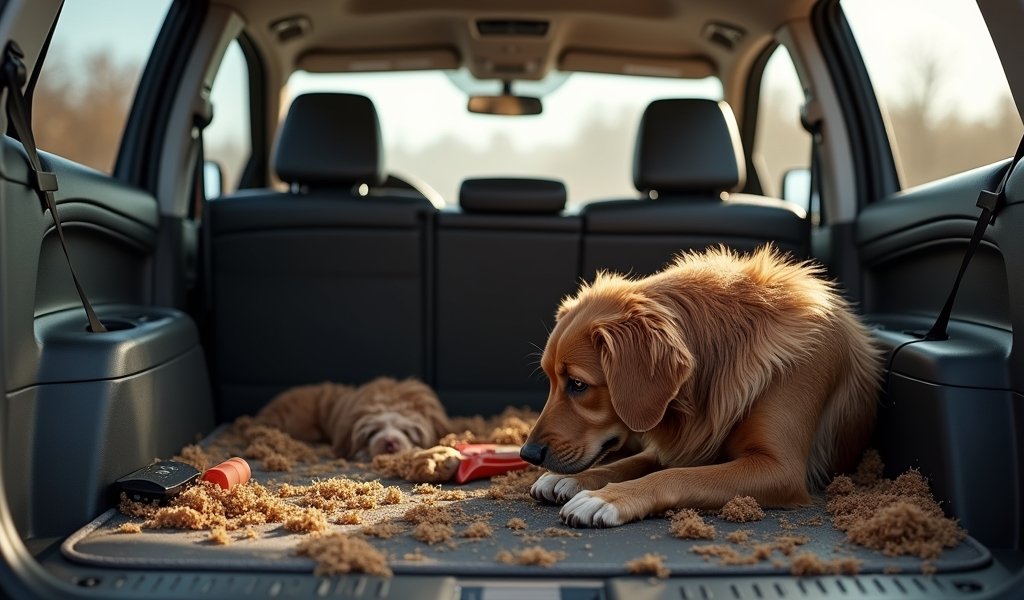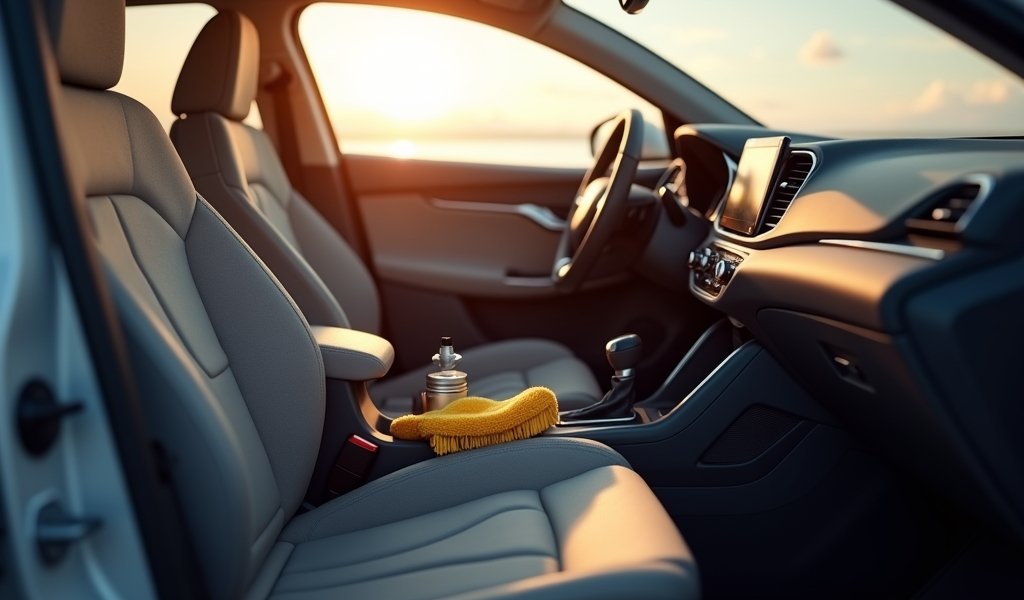Overview
This article provides practical strategies for pet owners to maintain clean vehicles, including essential accessories like waterproof seat covers and cargo liners, daily maintenance routines, deep cleaning techniques for pet hair and odors, and stain removal methods. The author emphasizes that prevention through proper accessories and consistent short cleaning sessions after each trip is more effective than infrequent deep cleaning, ultimately preserving both vehicle value and travel enjoyment with pets.
Table of Contents
- Introduction: Keeping Your Car Clean with Pets
- Essential Pet Car Accessories for Cleanliness
- Daily Maintenance Tips for Pet-Friendly Vehicles
- Deep Cleaning Techniques for Pet Hair and Odors
- Stain Removal Strategies for Pet Accidents
- Preventative Measures to Keep Your Car Clean
- Conclusion
- Frequently Asked Questions
Introduction: Keeping Your Car Clean with Pets
As a mechanic who’s seen thousands of vehicles come through my shop over the years, I’ve noticed a clear pattern: cars with pet passengers require special attention. Pet car accessories aren’t just about making Fido comfortable during rides—they’re essential tools in maintaining your vehicle’s cleanliness, value, and that fresh-car smell we all love.
Whether you’re taking your furry friend on daily commutes or weekend adventures, their hair, drool, and occasional accidents can take a serious toll on your car’s interior. I’ve helped countless pet owners tackle these challenges, and I’m here to share professional tips that actually work.
In this guide, we’ll explore the most effective pet car accessories for keeping your vehicle clean, along with five expert cleaning techniques that will transform how you maintain your car. Having worked with everything from luxury vehicles to family minivans, I’ve refined these strategies to work for any vehicle type and pet breed.
Let’s dive into practical solutions that will make traveling with your pet enjoyable for everyone—without sacrificing your car’s condition in the process.
Essential Pet Car Accessories for Cleanliness
Before we get to cleaning techniques, let’s talk about prevention. The right pet car accessories can dramatically reduce the time you spend cleaning. Based on my experience with countless pet owners, these five essentials make the biggest difference:
Quality car seat covers designed for pets are your first line of defense. Look for waterproof, scratch-resistant options that fully cover the seating area. The best ones feature non-slip backing and secure attachment points to prevent shifting during drives. This simple addition can save hours of cleaning time.
Barrier systems or pet carriers provide containment that limits where pet hair and dirt can spread. A sturdy barrier between the cargo area and passenger space keeps your pet secure while protecting most of your interior from hair distribution. For smaller pets, a well-ventilated carrier serves the same purpose while adding extra safety.
Door protectors are often overlooked but incredibly valuable. Dogs especially tend to paw at windows and doors, leaving scratches and drool streaks. Transparent vinyl door covers protect your interior while remaining nearly invisible. They’re inexpensive but can prevent costly damage to door panels.
Cargo liners designed specifically for pets offer full coverage of your trunk or cargo area with raised edges to contain accidents and spills. The best options are custom-fit to your vehicle model and made from durable, waterproof materials that can be easily removed for cleaning.
Portable vacuum cleaners designed for pet hair can be game-changers. Look for compact, high-suction models with specialized pet hair attachments. Keeping one in your vehicle means you can quickly address hair accumulation before it becomes embedded in fabrics. According to Consumer Reports, immediate vacuuming prevents hair from bonding with upholstery fibers.
When shopping for these accessories, prioritize durability and ease of cleaning over aesthetics. The most attractive pet accessories often sacrifice functionality. As someone who’s seen the aftermath of poorly designed products, I recommend investing in quality items upfront—they’ll save you money on interior repairs down the road.

Daily Maintenance Tips for Pet-Friendly Vehicles
Daily maintenance is the secret to keeping pet-friendly vehicles in top condition. Based on my experience in auto detailing, these quick habits prevent buildup that would otherwise require intensive cleaning sessions:
Keep microfiber towels and a small hand vacuum in your glove compartment or door pocket. After each ride with your pet, take two minutes to wipe down surfaces and quickly vacuum visible hair. This prevents oils from paws and fur from penetrating upholstery fibers.
Use lint rollers strategically on fabric surfaces. The adhesive sheets can quickly collect loose fur before it becomes embedded. I recommend keeping one in your car at all times, especially during shedding season. A quick roll over seats after your pet exits can prevent 80% of deep cleaning work later.
Rubber gloves are surprisingly effective for pet hair removal. Simply put them on and run your hand over fabric surfaces—the friction creates static electricity that lifts hair from upholstery. Dampen the gloves slightly for even better results on stubborn areas.
Create a simple “pet clean-up kit” to keep in your vehicle. Include pet-safe wet wipes for quick paw cleaning before your dog enters the car, especially after muddy walks or beach trips. This small step can prevent dirt from entering your vehicle in the first place.
Maintain consistent air circulation in your vehicle. Crack windows slightly when parked (weather permitting) or use a car air purifier designed for pet odors. Fresh airflow prevents odors from becoming trapped in your car’s ventilation system and upholstery.
The key to daily maintenance is consistency. In my years helping pet owners maintain their vehicles, I’ve noticed that those who spend just 2-3 minutes after each trip have dramatically cleaner cars than those who attempt intensive cleaning sessions less frequently. Make these habits automatic, and you’ll significantly extend the life of your car’s interior.
Deep Cleaning Techniques for Pet Hair and Odors
Even with the best daily habits, your car will occasionally need deeper cleaning to address accumulated pet hair and odors. Here are professional techniques I’ve refined over years of working with pet owners:
For embedded pet hair in upholstery, use a pumice stone with light pressure in a single direction across fabric surfaces. The rough texture catches hair without damaging most car upholstery fabrics. Follow with a vacuum to collect loosened hair. This technique works remarkably well on carpeted floor mats and cargo areas.
Create a DIY odor neutralizer by mixing one part white vinegar with two parts water in a spray bottle. Lightly mist (don’t soak) fabric surfaces and allow to air dry with windows open. The vinegar smell dissipates quickly while neutralizing pet odors at the molecular level rather than masking them. Research from the American Chemical Society confirms vinegar’s effectiveness in breaking down odor compounds.
For serious odor issues, consider an enzyme cleaner specifically formulated for pet accidents. These products contain beneficial bacteria that consume odor-causing compounds. Apply according to directions, ensuring the enzymes have sufficient time to work—usually several hours. This approach is particularly effective for urine accidents that may have penetrated to the padding beneath upholstery.
Address your car’s ventilation system by replacing the cabin air filter. Pet dander and hair can become trapped in this filter, circulating odors throughout your vehicle each time you use the air conditioning or heater. Most filters can be replaced in under 15 minutes following your owner’s manual instructions.
For leather or vinyl surfaces, use a cleaner specifically designed for these materials followed by a conditioner. Pet nails can create micro-scratches that collect dirt and oils, making surfaces appear dull. The conditioner helps restore the material’s protective barrier. Apply every 2-3 months for optimal protection.
When deep cleaning, work from top to bottom and back to front in your vehicle. This prevents recontaminating cleaned areas. Also, choose a dry, low-humidity day for deep cleaning to allow proper drying, reducing the risk of mildew development in freshly cleaned upholstery.
Stain Removal Strategies for Pet Accidents
Accidents happen, especially with anxious pets or during longer journeys. The key to effective stain removal is quick action and using the right techniques for different types of accidents:
For fresh liquid accidents, blot (don’t rub) with absorbent microfiber towels to remove as much moisture as possible. Press firmly, working from the outside edges toward the center to prevent spreading. Once you’ve absorbed the majority of liquid, apply a pet-specific enzymatic cleaner according to product directions.
For dried stains that have set in, create a cleaning solution of equal parts water and white vinegar with a drop of dish soap. Apply lightly to the stain, allow it to sit for 5-10 minutes, then blot with clean towels. The vinegar helps break down proteins in organic stains while the soap lifts away oils. Repeat if necessary before applying an enzymatic cleaner.
For stubborn stains on carpeted areas, try the “steam and extract” method. After treating with appropriate cleaners, cover the area with a damp white towel. Press with a hot iron (no steam) for 10-15 seconds, which transfers the stain from the upholstery to the towel. This technique works surprisingly well for old, set-in stains.
Always test cleaning solutions on an inconspicuous area first, particularly with waterproof car seat covers or specialty fabrics. Some solutions can affect color or texture on certain materials. A simple test in a hidden area can prevent further damage.
For odor elimination after stain removal, baking soda is remarkably effective. Once the area is clean and nearly dry, apply a thin layer of baking soda and allow it to sit overnight. Vacuum thoroughly the next day. The baking soda absorbs remaining odors and moisture.
Remember that sunlight is a powerful deodorizer and disinfectant. After cleaning a stain, park your car with windows cracked in direct sunlight if possible. UV rays help eliminate remaining bacteria that cause odors. Just be cautious with leather interiors, as extended sun exposure can cause drying and cracking.

Preventative Measures to Keep Your Car Clean
Prevention is always easier than cleaning. After years of helping pet owners maintain their vehicles, these preventative strategies have proven most effective:
Exercise your pet before car trips whenever possible. A tired dog is less likely to be anxious or overly excited in the car, reducing drooling, shedding, and accident risks. Even a quick 10-minute walk can make a significant difference in your pet’s car behavior.
Create a “car entry routine” for your pet. Keep grooming supplies near where you typically load your pet into the vehicle. A quick brush-out before entering captures loose fur that would otherwise end up in your car. For muddy paws, keep pet wipes or a small towel handy.
Consider using washable pet clothing for car rides. Special “shed defender” bodysuits for dogs can reduce shedding by over 80% during car rides. These lightweight outfits are comfortable for most pets and dramatically reduce cleanup time.
Apply a fabric protector spray to upholstery not covered by seat protectors. Products like Scotchgard create an invisible barrier that prevents liquids and stains from penetrating fabric fibers, making cleanup significantly easier. Reapply every 6-12 months for continued protection.
Train your pet to enter and exit from one specific door only. This concentrates any dirt or hair accumulation to one area of your vehicle that you can focus on protecting and cleaning. Most pets adapt quickly to this routine with consistent practice.
Schedule quarterly professional detailing if budget allows. Professional equipment can extract deeply embedded hair and dander that home cleaning might miss. Many detailing services offer pet-specific packages designed to address common issues pet owners face.
For daily commuters with pets, consider keeping a designated “car blanket” that can be easily washed weekly. Place this over your existing seat covers for an additional layer of protection that’s simple to maintain. The easier you make cleaning, the more likely you’ll stay consistent with it.
Conclusion
Traveling with pets doesn’t have to mean sacrificing your car’s cleanliness or value. With the right pet car accessories and cleaning strategies, you can enjoy your furry companion’s company while maintaining a vehicle that still looks, smells, and feels fresh.
Remember that consistency is key—small daily efforts prevent the need for intensive cleaning sessions. Invest in quality protective accessories upfront, develop simple cleaning habits, and address accidents promptly when they occur.
The bond you share with your pet during travels creates priceless memories. By implementing these professional tips, you can focus on the journey rather than worrying about the cleanup afterward. Your vehicle will thank you with better resale value, and your passengers will appreciate a clean, odor-free environment.
Whether you’re taking short trips to the park or cross-country adventures, these strategies will help ensure that your car remains a welcoming space for both human and furry passengers alike. Safe travels!
Frequently Asked Questions
What’s the best way to remove pet hair from car upholstery?
A rubber glove or pumice stone works best for embedded pet hair in fabric upholstery. Simply run the slightly dampened rubber glove or dry pumice stone across the surface, then vacuum up the loosened hair.
How often should I clean my car when traveling regularly with pets?
Quick 2-minute cleanups after each trip and a thorough cleaning every 2-3 weeks is ideal. Daily maintenance prevents buildup that makes deeper cleaning more difficult.
Can pet odors permanently damage my car’s interior?
Untreated pet odors can penetrate materials and become nearly impossible to remove completely. Prompt cleaning with enzymatic cleaners prevents permanent odor absorption into upholstery padding and ventilation systems.
Are universal or custom-fit pet car seat covers better?
Custom-fit covers designed for your specific vehicle model provide better coverage and stay in place more securely during travel. The additional cost is worthwhile for regular pet transportation.
How can I prevent my dog from getting car sick and creating messes?
Gradually acclimate your dog to car travel with short trips, ensure good ventilation, and avoid feeding 2-3 hours before travel. For chronically car-sick pets, consult your veterinarian about appropriate motion sickness medications.


Pingback: Cat Travel Carrier for Car: 3 Best Picks - knowsyourcar.com
Pingback: Protect Car Seats from Food and Drink! - knowsyourcar.com